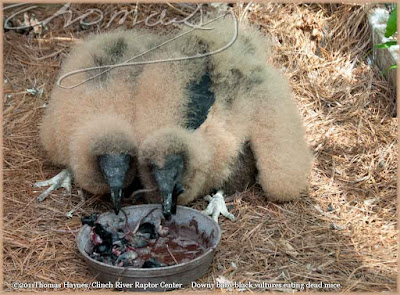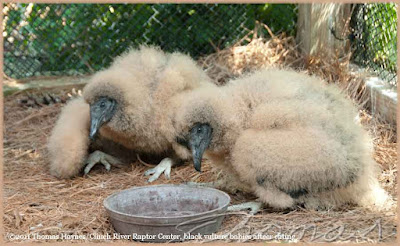A hissssssssss is the sound of baby vultures. Of course when eating, there is much less hisssssss and a lot more chopping sound of beaks taking in a nice treat of deceased mice.
Three weeks later, notice the black wings showing as down is lost and wing feathers emerge.
The photo below is approximately 5 weeks later than the first photograph of the black vultures covered with down.
While in captivity, the vultures are given little attention except for feeding and cage cleaning. Why are these birds not allowed to socialize with humans? Have you heard of imprinting? There are stories of a newly born chicken emerging from the egg and the first view is a person. The chick then follows the person around "believing" that person is its mother. How true are the chicken stories I do not know. What is fact is that young birds can be imprinted on humans, losing their own identity and considering the human "their type". Once imprinted, the birds cannot be released into the wild as healthy birds should be. They become dependent on people, not fearful and have likely lost the ability to socialize with their own kind. At the Clinch River Raptor Center the aim is to restore baby birds to the wild, where they were intended to be. Survival depends on not being friends with people and learning to be what they are...vultures. With the down gone, the vultures grow into sleek, well designed birds as is seen later in this post.
Vulture mantle ornament, black bears with pink snouts...
its madness! The gloved hand holding the jesses of this black vulture let you know this is a real, living bird. She was part of a demonstration at Amicalola Falls State Park, Georgia. This bird is imprinted and has no place in the wild. As it is, being social with humans dooms the bird to a life of education for people...and very good care with regular meals topping normal road kill. The whiter feathers on the ends of the wings and the gray head identifies this as a black vulture. The flying vulture photo at the end is a turkey vulture, two tone wings from below without the highly contrasted light wing tips. Turkey vultures also have a red face.
Obviously, those cute stuffed animals are not black bears and look most like Asian Honey Bears. Coloring black bears this way is commonplace, not unlike giving all cartoon crows a yellow beak. The colors of the black vulture are real.
Going bald, a sign of maturity or old age...with vultures going bald is an expected and needed part of getting out of the teenage years. If you are dipping your face into the carcass of a dead animal, feathers matted with last night's supper is not desirable. The bald head helps keep the face clean, as possibly the featherless legs help keep the legs clean of dead animal matter. Making a meal of fresh carrion is the scavenger way of survival. Freshly dead is preferred to road pancakes. Stomach acids are quite as is the immune system of which the strong digestive acids must play a part. You do not want vulture vomit on your skin.
The following two photos show a transition of hairline in a vulture growing up. Note the dates of the photos in the upper left corners. Click to see and enlarged version of the photograph.
And finally here is a photograph of a Turkey Vulture. This is flying in the wild above Center Hill Lake in Tennessee. Turkey vultures go further north than do black vultures and the reason has to do with slide. A black vulture will slide down while soaring at a quicker rate than does a turkey vulture. This means the black vulture needs stronger thermals (uplifts of rising air) to help it stay aloft and soar for long periods of time. Southern areas have stronger thermals suited for the black vulture and northern areas have weaker thermals. The turkey vulture does fine in northern thermals but the air is too weak to help the black vulture stay aloft while soaring...and vultures are known for soaring. Black vultures stay mostly in southern areas.
----------------------------------------
ABOUT THE VULTURES FEATURED IN THIS POST
The babies were found apparently lost or otherwise separated from their parents. These were raised until ready to be transferred to caretakers who specialize in vultures. Often, the birds may be united with a flock of wild birds. I am not certain where these birds went. They did leave in healthy condition.
The vulture demonstrating "how to go bald" was also transferred.
-------------------------------------
There are no buzzards in this post.
Although vultures are generally called buzzards in the USA,
buzzard is the appropriate name for soaring hawks, as used in the United Kingdom. The word has been misused for years.
That being said, I do not call vultures "buzzards".
Still, there is no way I can bring myself to call hawks buzzards.

















